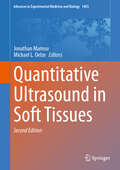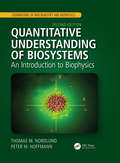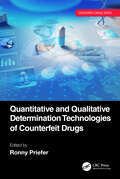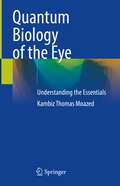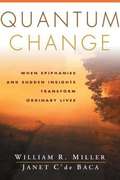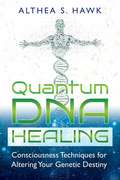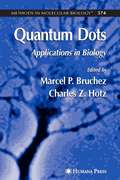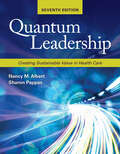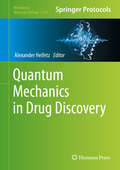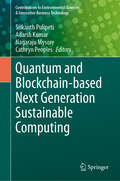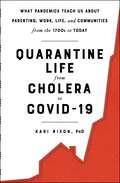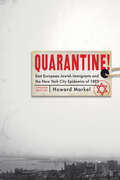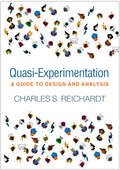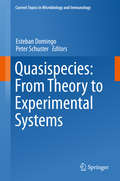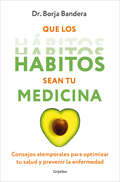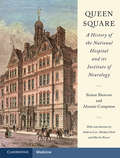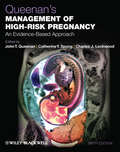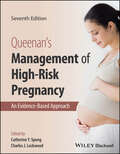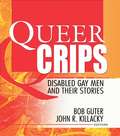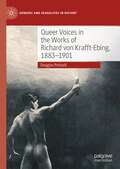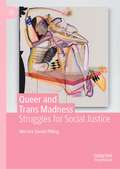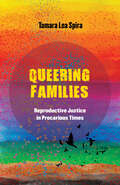- Table View
- List View
Quantitative Ultrasound in Soft Tissues (Advances in Experimental Medicine and Biology #1403)
by Jonathan Mamou Michael L. OelzeQuantitative ultrasound (QUS) continues to mature as a research field and is primed to make a swift transition to routine preclinical and clinical applications. This book will serve two main purposes: Advanced education in QUS by providing a complete and thorough review of all theoretical, physical, and engineering aspects of QUS.Review of recent development of QUS by lead contributors in the research field. This 2nd edition will focus on 6 modern research topics related to quantitative ultrasound of soft tissues: Spectral-based methods for tissue characterization, tissue typing, cancer detection, etc.Attenuation estimation for tissue characterization and improving spectral based methodsEnvelope statistics analysis as a means of quantifying and imaging tissue properties.Ultrasound computed tomography for preclinical and clinical imaging.Scanning acoustic microscopy for forming images of mechanical properties of soft tissues with micron resolution.Phantoms for quantitative ultrasound.
Quantitative Understanding of Biosystems: An Introduction to Biophysics, Second Edition (Foundations of Biochemistry and Biophysics)
by Peter M. Hoffmann Thomas M. NordlundPraise for the prior edition "The author has done a magnificent job… this book is highly recommended for introducing biophysics to the motivated and curious undergraduate student."―Contemporary Physics "a terrific text … will enable students to understand the significance of biological parameters through quantitative examples―a modern way of learning biophysics." ―American Journal of Physics "A superb pedagogical textbook… Full-color illustrations aid students in their understanding" ―Midwest Book Review This new edition provides a complete update to the most accessible yet thorough introduction to the physical and quantitative aspects of biological systems and processes involving macromolecules, subcellular structures, and whole cells. It includes two brand new chapters covering experimental techniques, especially atomic force microscopy, complementing the updated coverage of mathematical and computational tools. The authors have also incorporated additions to the multimedia component of video clips and animations, as well as interactive diagrams and graphs. Key Features: Illustrates biological examples with estimates and calculations of biophysical parameters. Features two brand-new chapters on experimental methods, a general overview and focused introduction to atomic force microscopy. Includes new coverage of important topics such as measures of DNA twist, images of nanoparticle assembly, and novel optical and electron nanoscopy. Provides a guide to investigating current expert biophysical research. Enhanced self-study problems and an updated glossary of terms.
Quantitative and Qualitative Determination Technologies of Counterfeit Drugs (Counterfeit Drugs Series)
by Ronny PrieferDrugs are often counterfeited to reduce manufacture costs, while still marketing it at as an authentic product. Increased incidence of drug counterfeiting is most noticeable in developing countries, which may not have the resources to supply counterfeit detection devices on a large scale. It is important to consider the problems caused and to propose options for controlling and reducing the prevalence of counterfeit medications. Various technologies are needed to identify the chemical properties of a questioned medicinal product, which can then be used to determine its authenticity. This volume focuses on current technological approaches that are able to detect counterfeited pharmaceuticals. Features • Focuses on current technological approaches that are able to detect counterfeited pharmaceuticals. • Assesses the chemical methods of identifying counterfeit medicinal products and explains the theoretical underpinnings of the methods. • Provides case study type examples of the application for analysis of suspected counterfeit pharmaceuticals. • Discusses the detection and analysis of counterfeit drugs, and appropriate tools for combating this issue. • The editor draws on his experience as a respected chemist and prolific author in the field to provide this unique text on drug counterfeiting detection.
Quantum Adaptivity in Biology: From Genetics to Cognition
by Andrei Khrennikov Masanari Asano Masanori Ohya Yoshiharu Tanaka Ichiro YamatoThis book examines information processing performed by bio-systems at all scales: from genomes, cells and proteins to cognitive and even social systems. It introduces a theoretical/conceptual principle based on quantum information and non-Kolmogorov probability theory to explain information processing phenomena in biology as a whole. The book begins with an introduction followed by two chapters devoted to fundamentals, one covering classical and quantum probability, which also contains a brief introduction to quantum formalism, and another on an information approach to molecular biology, genetics and epigenetics. It then goes on to examine adaptive dynamics, including applications to biology, and non-Kolmogorov probability theory. Next, the book discusses the possibility to apply the quantum formalism to model biological evolution, especially at the cellular level: genetic and epigenetic evolutions. It also presents a model of the epigenetic cellular evolution based on the mathematical formalism of open quantum systems. The last two chapters of the book explore foundational problems of quantum mechanics and demonstrate the power of usage of positive operator valued measures (POVMs) in biological science. This book will appeal to a diverse group of readers including experts in biology, cognitive science, decision making, sociology, psychology, and physics; mathematicians working on problems of quantum probability and information and researchers in quantum foundations.
Quantum Biology of the Eye: Understanding the Essentials
by Kambiz Thomas MoazedAs we enter the quantum era, new research on applying the rules of quantum physics to biology, which was previously considered impossible, has revolutionized our understanding and our concept of molecular and atomic particles behavior and their interactions. This book is the first comprehensive review of the quantum biology of the visual system. Chapters discuss the relevance of quantum physics to the biological systems, especially in the visual system. The main purpose of this book is to simplify quantum biology concepts relevant to physiology of human eye and to help the reader understand the essentials of this new emerging, complex and anti-intuitive field of science. It offers a contemporary view of the emerging interplay between the biochemistry, physiology, molecular biology, and molecular and atomic particle quantum characteristics such as vibration, spin etc.Quantum Biology of the Eye is an essential resource for Ophthalmologists, physicians, residents, fellows, all fields of visual science and medical students in ophthalmology, and other converging fields of science such as visual optics biochemists, psychology etc.
Quantum Change
by William Miller Janet C'DebacaMost of us walk through each day expecting few surprises. If we want to better ourselves or our lives, we map out a path of gradual change, perhaps in counseling or psychotherapy. Psychologists William Miller and Janet C'de Baca were longtime scholars and teachers of traditional approaches to self-improvement when they became intrigued by a different sort of change that was sometimes experienced by people they encountered something often described as "a bolt from the blue" or "seeing the light." And when they placed a request in a local newspaper for people's stories of unexpected personal transformation, the deluge of responses was astounding. These compelling stories of epiphanies and sudden insights inspired Miller and C'de Baca to examine the experience of "quantum change" through the lens of scientific psychology. Where does quantum change come from? Why do some of us experience it, and what kind of people do we become as a result? The answers that this book arrives at yield remarkable insights into how human beings achieve lasting change--sometimes even in spite of ourselves.
Quantum DNA Healing: Consciousness Techniques for Altering Your Genetic Destiny
by Althea S. HawkHow consciousness and quantum energies affect your genetic expression and the development of disease and chronic health conditions• Draws on cellular medicine, genetics, quantum physics, and consciousness studies to define the real underlying mechanisms of disease and how they can be addressed • Explains how consciousness influences quantum DNA to erase the genetic imprint of illness, allowing your body to remember how to function efficiently and effectively• Shares the author’s discoveries that enabled her to successfully heal the cellular dysfunction at the root cause of her cancer, tumors, chronic inflammation, and toxicity• Explores consciousness tools to re-encode DNA and includes detailed scripts for techniques that readers can apply to their own healing journeysDrawing on new advancements in quantum physics, cellular medicine, genetics, and consciousness studies, as well as her own journey of self-healing from a number of challenging health conditions, Althea S. Hawk reveals how you can consciously influence your DNA and re-encode it to improve your health and alter your genetic destiny.Sharing the discoveries that enabled her to successfully heal from her cancer, tumors, toxicity, and inflammatory-related conditions, the author explains how genes are not solely responsible for creating disease. She shows how human physiology interacts with the quantum energies of our external and personal environments and how the resulting information triggers the development and persistence of disease and chronic conditions. We each inherit susceptibilities, but it is our unique experience of these environmental factors, as well as our beliefs, thoughts, and emotions, that alter the way our genes are expressed. Detailing how our DNA is both quantum-energetic and biological-chemical, Hawk explains how your environment and your consciousness influence your quantum DNA, which in turn interacts with your biological DNA. By working directly with energetic information that affects how your quantum and biological DNA communicate, you can alter the expression of your genes by re-encoding the gene sequences on your physical DNA, erasing the imprint of illness and enabling your body to remember how to function properly.Hawk explores consciousness tools and mind-body techniques to re-encode your DNA, such as sound and breathing work, DNA marker removal, recalibration of Akashic information, and cellular communication exercises that readers can apply to their own healing journeys.
Quantum Dots
by Marcel Bruchez Charles Z. HotzQuantum Dots captures many diverse applications enabling utility in biological detection. Organized into five parts, the first two parts cover the use of QDs in imaging fixed and living cells (and tissues). Protocols are included for using QDs in routine as well as enabling applications. Part 3 shows early efforts aimed at using QDs in live animals. The final two parts demonstrate the versatility of QD technology in existing assay technology.
Quantum Leadership: Creating Sustainable Value in Health Care
by Nancy M. Albert Sharon PappasHealthcare organizations are experiencing rapid and complex changes in delivery of care, and nurses and health care providers must possess the leadership skills to navigate such change. Quantum Leadership: Creating Sustainable Value in Health Care, Seventh Edition provides strategies for handling periods of transformation while creating a healing environment for both providers and patients. With clarity and depth of detail, it features theories about contemporary leadership within today's complex and diverse healthcare delivery system. It works from a model of complexity leadership, in which leadership is not limited to those with certain titles but an attribute that every healthcare worker can develop for success in fast-moving, information-overloaded organizations. With Quantum Leadership: Creating Sustainable Value in Health Care, Seventh Edition, nursing students will feel confident in their leadership skills to manage changes in delivery of care with optimal patient-centered care.
Quantum Mechanics in Drug Discovery (Methods in Molecular Biology #2114)
by Alexander HeifetzThis volume looks at applications of quantum mechanical (QM) methods in drug discovery. The chapters in this book describe how QM approaches can be applied to address key drug discovery issues, such as characterizing protein-water-ligand and protein-protein interactions, providing estimates of binding affinities, determining ligand energies and bioactive conformations, refinement of molecular geometries, scoring docked protein–ligand poses, describing molecular similarity, structure–activity-relationship (SAR) analysis, and ADMET prediction. Written in the highly successful Methods in Molecular Biology series format, chapters include introductions to their respective topics, lists of the necessary software and tools, step-by-step, readily reproducible modeling protocols, and tips on troubleshooting and avoiding known pitfalls. Cutting-edge and unique, Quantum Mechanics in Drug Discovery is a valuable resource for structural and molecular biologists, computational and medicinal chemists, pharmacologists, and drug designers.
Quantum and Blockchain-based Next Generation Sustainable Computing (Contributions to Environmental Sciences & Innovative Business Technology)
by Adarsh Kumar Cathryn Peoples Srikanth Pulipeti Nagaraju MysoreQuantum and Blockchain technology innovations have recently gained a lot of attention and have been integrated with other contemporary technologies for numerous applications. As a result, these applications achieve sustainability, robustness, scalability, security, accountability, and efficiency. Thus, this book covers the principles, terminologies, methods, protocols, and sustainability of quantum and blockchain technology. Furthermore, it provides insights into numerous challenges associated with other domains of computer science. In addition, the book provides various opportunities to integrate the quantum and blockchain technology-based sustainable solutions that incorporate low-cost, quality of services, secure and faster delivery of services for future demands in the fields such as cryptography, artificial intelligence (AI), machine learning (ML), deep learning (DL), computer vision, healthcare, autonomous vehicles, transportation, information, and communication theory. The information in this book is extremely useful for readers and practitioners in different fields including chemistry, mechanical and automotive engineering, healthcare, computer science, data science, and business analysis specialists in combining both basic and advanced level principles.
Quarantine Life from Cholera to COVID-19: What Pandemics Teach Us About Parenting, Work, Life, and Communities from the 1700s to Today
by Kari NixonFor readers of Mary Roach and Adam Diamond, an innovative look at the histories of different epidemics and what it meant for society, alongside what lessons different diseases have to teach us as society battles the novel Coronavirus.Throughout history, there have been numerous epidemics that have threatened mankind with destruction. Diseases have the ability to highlight our shared concerns across the ages, affecting every social divide from national boundaries, economic categories, racial divisions, and beyond. Whether looking at smallpox, HIV, Ebola, or COVID-19 outbreaks, we see the same conversations arising as society struggles with the all-encompassing question: What do we do now? Quarantine Life from Cholera to COVID-19 demonstrates that these conversations have always involved the same questions of individual liberties versus the common good, debates about rushing new and untested treatments, considerations of whether quarantines are effective to begin with, what to do about healthy carriers, and how to keep trade circulating when society shuts down. This immensely readable social and medical history tracks different diseases and outlines their trajectory, what they meant for society, and societal questions each disease brought up, along with practical takeaways we can apply to current and future pandemics—so we can all be better prepared for whatever life throws our way.
Quarantine!: East European Jewish Immigrants and the New York City Epidemics of 1892
by Howard MarkelThis riveting story of the typhus and cholera epidemics that swept through New York City in 1892 has been updated with a new preface that tackles the COVID-19 pandemic.Winner, 2003 Arthur J. Viseltear Prize for Outstanding Book in the History of Public Health, American Public Health AssociationIn Quarantine! Howard Markel traces the course of the typhus and cholera epidemics that swept through New York City in 1892. The story is told from the point of view of those involved—the public health doctors who diagnosed and treated the victims, the newspaper reporters who covered the stories, the government officials who established and enforced policy, and, most importantly, the immigrants themselves. Drawing on rarely cited stories from the Yiddish American press, immigrant diaries and letters, and official accounts, Markel follows the immigrants on their journey from a squalid and precarious existence in Russia's Pale of Settlement, to their passage in steerage, to New York's Lower East Side, to the city's quarantine islands.This updated edition features a new preface from the author that reflects on the themes of the book in light of the COVID-19 pandemic. At a time of renewed anti-immigrant sentiment and newly emerging infectious diseases, Quarantine! provides a historical context for considering some of the significant problems that face American society today.
Quasi-Experimentation: A Guide to Design and Analysis (Methodology in the Social Sciences)
by Charles S. ReichardtFeaturing engaging examples from diverse disciplines, this book explains how to use modern approaches to quasi-experimentation to derive credible estimates of treatment effects under the demanding constraints of field settings. Foremost expert Charles S. Reichardt provides an in-depth examination of the design and statistical analysis of pretest–posttest, nonequivalent groups, regression discontinuity, and interrupted time-series designs. He details their relative strengths and weaknesses and offers practical advice about their use. Comparing quasi-experiments to randomized experiments, Reichardt discusses when and why the former might be a better choice than the latter in the face of the contingencies that are likely to arise in practice. Modern methods for elaborating a research design to remove bias from estimates of treatment effects are described, as are tactics for dealing with missing data and noncompliance with treatment assignment. Throughout, mathematical equations are translated into words to enhance accessibility. Adding to its discussion of prototypical quasi-experiments, the book also provides a complete typology of quasi-experimental design options to help the reader craft the best research design to fit the circumstances of a given study.
Quasispecies: From Theory to Experimental Systems
by Peter Schuster Esteban DomingoThis volume brings together recent developments in quasispecies theory extended to variable environments and practical applications in elucidating viral dynamics and treatment designs. In particular, the existence of an error threshold in rugged fitness landscapes has opened the way to a new antiviral strategy termed lethal mutagenesis, which is now under intensive theoretical, experimental and clinical investigation. As such the book explains how an understanding of quasispecies dynamics within infected organisms has increased our knowledge of viral disease events. From a clinical perspective, population dynamics highlights important problems for viral disease control, such as the selection of drug-resistant mutants that often accompanies treatment failures, and suggests means of increasing the effectiveness of antiviral treatments. The book is intended for students and scientists interested in basic and applied aspects of biophysics, chemistry, biology, evolution and medical virology.
Que los hábitos sean tu medicina: Consejos atemporales para optimizar tu salud y prevenir la enfermedad
by Borja Bandera Merchán«Borja tiene una manera de transmitir, compartir y hacer llegar su conocimiento y experiencia que me gusta: con respeto y humildad»Andrés Iniesta Claves sencillas para optimizar tu salud. Pequeños y poderosos cambios para prevenir la enfermedad y gozar de una longevidad saludable. Este libro actuará en ti como un catalizador que te animará a ponerte en acción para mejorar tu salud. Se trata de un ameno compendio de textos cortos que recoge los principales requisitos atemporales para optimizar tu salud. El doctor Borja Bandera aporta las herramientas necesarias para modificar tu conducta, te hace dueño de las decisiones que afectan a tu bienestar y te involucra en el proceso de recuperación: te empodera. Que los hábitos sean tu medicina, optimista, certero y lleno de energía positiva, ayuda a entender los atajos que conducen al cambio de hábitos para que cuidarte sea placentero. Y es que la soledad puede ser mucho peor que tener el colesterol alto, y la salud es mucho más que tomar medicamentos.
Queen Square: A History Of The National Hospital And Its Institute Of Neurology
by Andrew Lees Martin Rossor Alastair Compston Simon Shorvon Michael J. ClarkAs the first neurological hospital in the world, founded in 1859, the National Hospital, Queen Square, and its affiliated Institute of Neurology remain leading neurological centres providing exceptional clinical services, teaching and research. Illustrated by over 100 historical images and much unpublished archival material, this book provides a comprehensive history of the National Hospital, the Institute, and their staff. It relates the ups and downs of the Hospital and Institute in war and peacetime, their financial struggles, many personality conflicts, efforts to remain independent and to maintain neurological dominance, academic and clinical contributions, issues relating to specialisation and subspecialisation and relations between disciplines, and the changing roles of the Hospital and Institute. The history is told from varying perspectives against the backdrop of the evolution of British clinical neuroscience, the special position of London medicine, and the influence of world wars, and is set in the context of modern British social history.
Queen Victoria's Gene: Haemophilia and the Royal Family
by D M Potts W T W PottsQueen Victoria's son, Prince Leopold, died from haemophilia, but no member of the royal family before his generation had suffered from the condition. Medically, there are only two possibilities: either one of Victoria's parents had a 1 in 50,000 random mutation, or Victoria was the illegitimate child of a haemophiliac man. However the haemophilia gene arose, it had a profound effect on history. Two of Victoria's daughters were silent carriers who passed the disease to the Spanish and Russian royal families. The disease played a role in the origin of the Spanish Civil War; and the tsarina's concern over her only son's haemophilia led to the entry of Rasputin into the royal household, contributing directly to the Russian revolution.
Queenan's Management of High-Risk Pregnancy
by Charles J. Lockwood Catherine Y. Spong John T. QueenanFor the maternal-fetal physician, constant vigilance throughout a pregnancy remains essential. But continuous change makes this an increasing challenge. Queenan's Management of High-Risk Pregnancy covers the full spectrum of perinatal care. Providing evidence, algorithms, and case studies, this book guides you through the tough and complex decisions needed to protect the health of both your fetal and the maternal patients. New material in the 6th edition covers contemporary issues such as, iron-deficient anemia, malaria, pregnancy in the disabled woman, placenta accrete, induction of labor, operative vaginal delivery, and patient safety in labor and delivery. Written by experts in the field, no obstetrician or obstetric health care provider can afford to miss Queenan's Management of High-Risk Pregnancy.
Queenan's Management of High-Risk Pregnancy: An Evidence-Based Approach
by Charles J. Lockwood Catherine Y. SpongQueenan's Management of High-Risk Pregnancy The new edition of the long-standing classic text, covering all areas of perinatal medicine Continuing to set the standard for maternal-fetal practice, the seventh edition of Queenan's Management of High-Risk Pregnancy provides practical, clinically useful information on the full spectrum of perinatal care. Focused on clinical decision-making, this invaluable reference contains authoritative, evidence-based information on the factors of high-risk pregnancy, biochemical and biophysical monitoring, maternal disease, obstetric complications, patient safety in labor and delivery, and more. With more than 50 concise chapters, this text has been written by leading experts, and contains evidence-based protocols, algorithms, case studies, potential outcome measures, medications, and illustrative case reports to ensure the best possible outcomes for fetal and maternal patients. This text offers clear guidance on the common problems encountered in the day-to-day management of high-risk pregnancies. The seventh edition of Queenan's Management of High-Risk Pregnancy includes new and updated chapters with the most current evidence-based information and protocols available on topics such as infectious diseases in pregnancy, vaping, operative vaginal delivery, postpartum hemorrhage, pregnancies in women with disabilities, maternal anemia, malaria, and HIV infection. Queenan's Management of High-Risk Pregnancy: An Evidence-Based Approach, Seventh Edition, remains an indispensable reference and guide for obstetricians, gynecologists, OB/GYN trainees, midwives, and primary and general practitioners.
Queer Crips: Disabled Gay Men and Their Stories
by Bob Guter John R KillackyGet an inside perspective on life as a disabled gay man! Queer Crips: Disabled Gay Men and Their Stories reverberates with the sound of "cripgay" voices rising to be heard above the din of indifference and bias, oppression and ignorance. This unique collection of compelling first-person narratives is at once assertive, bold, and groundbreaking, filled with characters-and character. Through the intimacy of one-on-one storytelling, gay men with mobility and neuromuscular disorders, spinal cord injury, deafness, blindness, and AIDS, fight isolation from society-and each other-to establish a public identity and a common culture. Queer Crips features more than 30 first-hand accounts from a variety of perspectives, illuminating the reality of the everyday struggle disabled gay men face in a culture obsessed with conformist good looks. Themes include rejection, love, sex, dating rituals, gaycrip married life, and the profound difference between growing up queer and disabled, and suffering a life-altering injury or illness in adulthood. Co-edited by Bob Guter, creator and editor of the webzine BENT: A Journal of Cripgay Voices, the book includes: two performance pieces from acclaimed author and actor Greg Walloch poetry from Chris Hewitt, Joel S. Riche, Raymond Luczak, Mark Moody, and co-editor John Killacky essays from BENT contributors Blaine Waterman, Raymond J. Aguilera, Danny Kodmur, Thomas Metz, Max Verga, and Eli Clare interviews with community activist Gordon Elkins and Alan Sable, one of the first self-identified gay psychotherapists in the United States and much more! Queer Crips is a forum for neglected cripgay voices speaking words that are candid, edgy, bold, dreamy, challenging, and sexy. The book is essential reading for academics and students working in lesbian and gay studies, and disability studies, and for anyone who's ever visited the place where queerness and disability meet.
Queer Ducks (and Other Animals): The Natural World of Animal Sexuality
by Eliot SchreferThis groundbreaking illustrated YA nonfiction title from two-time National Book Award finalist and New York Times bestselling author Eliot Schrefer is a well-researched and teen-friendly exploration of the gamut of queer behaviors observed in animals.A quiet revolution has been underway in recent years, with study after study revealing substantial same-sex sexual behavior in animals. Join celebrated author Eliot Schrefer on an exploration of queer behavior in the animal world—from albatrosses to bonobos to clownfish to doodlebugs.In sharp and witty prose—aided by humorous comics from artist Jules Zuckerberg—Schrefer uses science, history, anthropology, and sociology to illustrate the diversity of sexual behavior in the animal world. Interviews with researchers in the field offer additional insights for readers and aspiring scientists.Queer behavior in animals is as diverse and complex—and as natural—as it is in our own species. It doesn’t set us apart from animals—it bonds us even closer to our animal selves.
Queer Voices in the Works of Richard von Krafft-Ebing, 1883–1901 (Genders and Sexualities in History)
by Douglas PretsellThis book is a critical edition of the autobiographical case studies used by the Austro-German psychiatrist Richard von Krafft-Ebing between 1883 and 1901. Forty-one individual case studies of same-sex attracted men and women, in their own words, made an eye-catching component of Krafft-Ebing’s most important work, PsychopathiaSexualis. Although the psychiatrist probably edited the autobiographical case studies, with the racier passages rendered in rather rudimentary Latin, what is particularly remarkable is that he preserved an unmistakeable queer discourse in some of the case studies that disputed the pathologising ideologies of the psychiatric texts in which they were embedded. Most of the autobiographies of same-sex attracted men follow the discursive patterns established in nineteenth-century psychiatry in providing descriptions of body features including genital size and shape, mental and physical health, family histories of health and disease, and accounts of life events from childhood to the present. This was because these men had been following Krafft-Ebing’s works and were now using their autobiographical contributions in Psychopathia Sexualis as a platform for negotiating the parameters of sexual orientation. Women’s sexuality was a relatively undeveloped component of Krafft-Ebing’s sexology but there are four case studies of women containing autobiographical content. Similarly, gender variance was hardly differentiated from sexuality at this period, but there are three autobiographies that clearly articulate cross gender identification, anticipating the future categories of transsexual and transgender. Krafft-Ebing reserved his therapeutic interventions to those individuals attracted to both sexes where hypnosis could supress same sex urges. Seven of these individuals supplied sexual autobiographies with two of them undergoing treatment as part of the overall case study. Together, these forty-one accounts give the reader a window into queer self-conceptions in Austria and Germany as the nineteenth century drew to a close.
Queer and Trans Madness: Struggles for Social Justice
by Merrick Daniel PillingThis book urges those invested in social justice for 2SLGBTQ people to interrogate the biomedical model of mental illness beyond the diagnoses that specifically target gender and sexual dissidence. In this first comprehensive application of Mad Studies to queer and trans experiences of mental distress, Pilling advances a broad critique of the biomedical model of mental illness as it pertains to 2SLGBTQ people, arguing that Mad Studies is especially amenable to making sense of queer and trans madness. Based on empirical data from two qualitative research studies, this book includes analyses of inpatient chart documentation from a psychiatric hospital and interviews with those who have experienced distress. Using an intersectional lens, Pilling critically examines what constitutes mental health treatment and the impacts of medical strategies on mad queer and trans people. Ultimately, Queer and Trans Madness: Struggles for Social Justice explores the emancipatory promise of queer and trans madness, advocating for more resources to respond to crisis and distress in ways that are non-coercive, non-carceral, and honour autonomy as well as interdependence within 2SLGBTQ communities.
Queering Families: Reproductive Justice in Precarious Times (Reproductive Justice: A New Vision for the 21st Century)
by Tamara Lea SpiraEnvisioning queer futures where we lovingly wager everything for the world’s children, the planet, and all living beings against all odds, and in increasingly precarious times. Queering Families traces the shifting dominant meanings of queer family from the late twentieth century to today. With this book, Tamara Lea Spira highlights the growing embrace of normative family structures by LGBTQ+ movements—calling into question how many queers, once deemed unfit to parent, have become contradictory agents within the US empire’s racial and colonial agendas. Simultaneously, Queering Families celebrates the rich history of queer reproductive justice, from the radical movements of the 1970s through the present, led by Black, decolonial, and queer of color feminist activists. Ultimately, Spira argues that queering reproductive justice impels us to build communities of care to cherish and uphold the lives of those who, defying normativity’s violent stranglehold, are deemed to be unworthy of life. She issues the call to lovingly wager a future for the world’s children, the planet, and all living beings against all odds, and in increasingly perilous times.
